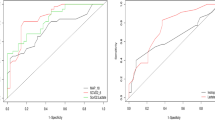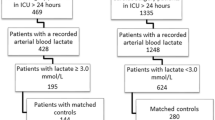Abstract
This study aimed to examine the association between lactate levels in the first hours after surgery for congenital heart defects and the results of Risk-Adjusted Classification for Congenital Heart Surgery (RACHS-1) scoring and to evaluate serial lactate levels over time to determine whether they can serve as a supplementary tool for postoperative assessment within the same RACHS-1 group of patients. A retrospective cohort study was performed using data retrieved from a clinical database of 255 children who had surgery for congenital heart defects between 1999 and 2001 at Sheba Medical Center. Lactate levels were measured postoperatively four times (mg/dL units). The last sample was taken at the end of the surgical procedure, and lactate levels were measured at admission to the pediatrics critical care unit, then 6 and 12 h after admission. The lactate level was measured via arterial blood gases. A total of 27 deaths occurred, yielding a mortality rate of 7.4% when Norwood operations were excluded and 10.16% when they were included. The mean initial postoperative lactate level was significantly lower for survivors (42.2 ± 32.0 mg/dL) than for nonsurvivors (85.4 ± 54.1 mg/dL) (p < 0.01). The serial mean lactate levels decreased progressively for all surviving patients (r 2 = 0.96) compared with nonsurvivors (r 2 = 0.02). The lactate levels correlated with the RACHS-1 subgroups at each time point (r 2 > 0.96 for all). The Pearson correlations between postoperative lactate levels (last lactate measurement taken in the operating room) and cardiopulmonary bypass (CPB) duration (r = 0.549), clamp duration (r = 0.586), and the inotropic score (r = 0.466) (p < 0.001 for all) were significantly positive. The correlations between the maximum lactate levels (during the first 12 postoperative hours) and CPB duration (r = 0.496), clamp duration (r = 0.509), and the inotropic score (r = 0.633) (p < 0.001 for all) were extremely positive. The early elevation of lactate levels in RACHS-1 subgroups 1 to 3 were highly correlated with poor prognosis and death (p < 0.03). In addition, the lactate levels differed significantly between survivors and nonsurvivors within the same RACHS-1 subgroup. The survivors in RACHS-1 subgroups 1 to 3 had lower mean lactate levels than the nonsurvivors in this group (P = 0.011), and this also held true for the survivors and nonsurvivors in RACHS-1 subgroups 4 to 6 (P = 0.026). Lactate levels differed significantly between survivors and nonsurvivors within the same RACHS-1 subgroup. This combination allows the targeting of appropriately intensive interventions and therapies toward the sickest patients.








Similar content being viewed by others
References
Abubacker M, Yoxall CW, Lamont G (2003) Perioperative blood lactate concentrations in preterm babies with necrotising enterocolitis. Eur J Pediatr Surg 13:35–39
Al-Radi OO, Harrell FE Jr, Caldarone CA, McCrindle BW, Jacobs JP, Williams MG, Van Arsdell GS, Williams WG (2007) Case complexity scores in congenital heart surgery: a comparative study of the Aristotle Basic Complexity score and the Risk Adjustment in Congenital Heart Surgery (RACHS-1) system. J Thorac Cardiovasc Surg 133:865–875
Bakker J, Gris P, Coffernils M, Kahn RJ, Vincent JL (1996) Serial blood lactate levels can predict the development of multiple organ failure following septic shock. Am J Surg 771:221–226
Basaran M, Sever K, Kafali E, Ugurlucan M, Sayin OA, Tansel T, Alpagut U, Dayioglu E, Onursal E (2006) Serum lactate level has prognostic significance after pediatric cardiac surgery. J Cardiothorac Vasc Anesth 20:43–47
Benavidez OJ, Gauvreau K, Del Nido P, Bacha E, Jenkins KJ (2007) Complications and risk factors for mortality during congenital heart surgery admissions. Ann Thorac Surg 84:147–155
Boethig D, Jenkins KJ, Hecker H, Thies WR, Breymann T (2004) The RACHS-1 risk categories reflect mortality and length of hospital stay in a large German pediatric cardiac surgery population. Eur J Cardiothorac Surg 26:12–17
Bourbia A, Cruz MA, Rozycki HJ (2005) NF-(kappa) B in tracheal lavage fluid from intubated premature infants: association with inflammation, oxygen, and outcome. Arch Dis Child Fetal Neonatal Ed 91:F36–39
Charpie JR, Dekeon MK, Goldberg CS, Mosca RS, Bove EL, Kulik TJ (2000) Serial blood lactate measurements predict early outcome after neonatal repair or palliation for complex congenital heart disease. J Thorac Cardiovasc Surg 120:73–80
Cheifetz IM, Kern FH, Schulman SR, Greeley WJ, Ungerleider RM, Meliones JN (1997) Serum lactates correlate with mortality after operations for complex congenital heart disease. Ann Thorac Surg 64:735–738
DeCampli WM, Burke RP (2009) Interinstitutional comparison of risk-adjusted mortality and length of stay in congenital heart surgery. Ann Thorac Surg 88:151–156
Deshpande SA, Platt MP (1997) Association between blood lactate and acid–base status and mortality in ventilated babies. Arch Dis Child Fetal Neonatal Ed 76 :F15–F20
Duke T, Butt W, South M, Karl TR (1997) Early markers of major adverse events in children after cardiac operations. J Thorac Cardiovasc Surg 114:1042–1052
Fuloria M (2002) Elevated plasma lactate levels: a tool for predicting outcomes or for improving care. Crit Care Med 30:2166–2167
Gogos CA, Lekkou A, Papageorgiou O, Siagris D, Skoutelis A, Bassaris HP (2003) Clinical prognostic markers in patients with severe sepsis: a prospective analysis of 139 consecutive cases. J Infect 47:300–306
Hannan RL, Ybarra MA, White JA, Ojito JW, Rossi AF, Burke RP (2005) Patterns of lactate values after congenital heart surgery and timing of cardiopulmonary support. Ann Thorac Surg 80:1468–1473 (discussion 1473–1474)
Jenkins KJ, Gauvreau K (2002) Center-specific differences in mortality: preliminary analyses using the Risk Adjustment in Congenital Heart Surgery (RACHS-1) method. J Thorac Cardiovasc Surg 124:97–104
Jenkins KJ, Gauvreau K, Newburger JW, Spray TL, Moller JH, Iezzoni LI (2002) Consensus-based method for risk adjustment for surgery for congenital heart disease. J Thorac Cardiovasc Surg 123:110–118
Kingman A, Zion G (1994) Some power considerations when deciding to use transformations. Stat Med 13:769–783
Kobayashi S, Gando S, Morimoto Y, Nanzaki S, Kemmotsu O (2001) Serial measurement of arterial lactate concentrations as a prognostic indicator in relation to the incidence of disseminated intravascular coagulation in patients with systemic inflammatory response syndrome. Surg Today 31:853–859
Lacour-Gayet F (2002) Risk stratification theme for congenital heart surgery. Semin Thorac Cardiovasc Surg Pediatr Card Surg Annu 5:148–152
Lacour-Gayet F, Jacobs ML, Jacobs JP, Mavroudis C (2007) The need for an objective evaluation of morbidity in congenital heart surgery. Ann Thorac Surg 84:1–2
Munoz R, Laussen PC, Palacio G, Zienko L, Piercey G, Wessel DL (2000) Changes in whole blood lactate levels during cardiopulmonary bypass for surgery for congenital cardiac disease: an early indicator of morbidity and mortality. J Thorac Cardiovasc Surg 119:155–162
Nguyen HB, Rivers EP, Knoblich BP, Jacobsen G, Muzzin A, Ressler JA, Tomlanovich MC (2004) Early lactate clearance is associated with improved outcome in severe sepsis and septic shock. Crit Care Med 32:1637–1642
O’Brien SM, Jacobs JP, Clarke DR, Maruszewski B, Jacobs ML, Walters HL 3rd, Tchervenkov CI, Welke KF, Tobota Z, Stellin G, Mavroudis C, Hamilton JR, Gaynor JW, Pozzi M, Lacour-Gayet FG (2007) Accuracy of the Aristotle basic complexity score for classifying the mortality and morbidity potential of congenital heart surgery operations. Ann Thorac Surg 84:2027–2037 (discussion 2027–2037)
Rossi AF, Khan DM, Hannan R, Bolivar J, Zaidenweber M, Burke R (2005) Goal-directed medical therapy and point-of-care testing improve outcomes after congenital heart surgery. Intensive Care Med 31:98–104
Siegel LB, Dalton HJ, Hertzog JH, Hopkins RA, Hannan RL, Hauser GJ (1996) Initial postoperative serum lactate levels predict survival in children after open heart surgery. Intensive Care Med 22:1418–1423
Stark JF, Gallivan S, Davis K, Hamilton JR, Monro JL, Pollock JC, Watterson KG (2001) Assessment of mortality rates for congenital heart defects and surgeons’ performance. Ann Thorac Surg 72:169–174 (discussion 174–175)
Tung RH, Garcia C, Morss AM, Pino RM, Fifer MA, Thompson BT, Lewandrowski K, Lee-Lewandrowski E, Januzzi JL (2004) Utility of B-type natriuretic peptide for the evaluation of intensive care unit shock. Crit Care Med 32:1643–1647
Welke KF, Shen I, Ungerleider RM (2006) Current assessment of mortality rates in congenital cardiac surgery. Ann Thorac Surg 82:164–170 (discussion 170–171)
Acknowledgment
We thank Ms. Esther Eshkol for her editorial assistance.
Author information
Authors and Affiliations
Corresponding author
Rights and permissions
About this article
Cite this article
Molina Hazan, V., Gonen, Y., Vardi, A. et al. Blood Lactate Levels Differ Significantly Between Surviving and Nonsurviving Patients Within the Same Risk-Adjusted Classification for Congenital Heart Surgery (RACHS-1) Group After Pediatric Cardiac Surgery. Pediatr Cardiol 31, 952–960 (2010). https://doi.org/10.1007/s00246-010-9724-7
Received:
Accepted:
Published:
Issue Date:
DOI: https://doi.org/10.1007/s00246-010-9724-7




